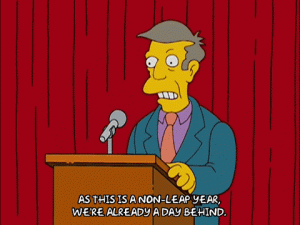Have you ever wondered why we have a Leap Year? Who created this extra day? Why February and not some other month like April or June, which have thirty days and can easily take an extra day for 31?
Leap Year is a relic of ancient astronomy. According to Stephen Wood of History.com, ancient calendars often had a 23-day intercalary or “extra month.” These extra months were based on the position of the moon as well as the Earth’s location relative to the sun. Originally, calendars were designed to track the Earth’s movement around the sun and ancient astronomers were extremely good at their jobs.
The Earth revolves around the sun 365.24 days and yet, a traditional calendar only accounts for 365 days. Therefore, there is a few hours gap each year as a result of the 365-day calendar. As a result, ancient astronomers created the intercalary to deal with this.
However, you may be asking, “Why February?” Julius Ceasar, that’s why. The father of the modern calendar decided the perfect calendar was created by the Egyptians. Egyptian solar calendars had 365 days and included one extra month. February was chosen to include the leap day as it was already a month where Romans added extra days.

Despite this attempt to account for the extra hours it takes for the Earth to revolve around the sun each year, the Julian (named after Ceasar) calendar, over the course of a century, made the equinoxes and solstices shift 24 days every century. As a result, Pope Gregory XIII expressed dismay that Easter was getting further and further away from the Spring Equinox.
Thus, the Gregorian calendar (the calendar that is used to this day) was born. Gregory kept Leap years and stipulated that they occur every four years and on years that begin a new century, in order to have a Leap day, the year must be divisible by 400. If the year is divisible by 100 evenly, it is not a Leap Year. In other words, if you lived at the start of the 20th century (1900), there was no Leap Year, but the year 2000 was divisible by 400 and thus, had a Leap Year.
Leap years are full of lore. Most famously, Leap Year is associated with Bachelor’s Day, as it is known in some countries. Bachelor’s Day is a day where women propose to men. This tradition is most identified with Ireland, St. Bridget, and St. Patrick (yes, that St. Patrick).
But if Ireland is an expense that you can ill-afford, plan a trip in four years to Anthony, Texas. Anthony is the self-proclaimed “Leap Year Capital of the World” with a festival that begins before the end of February and goes to March. This year, it is scheduled for February 28th until March 2nd, 2020. Additionally, Leap Year can also be a time of great superstitions around livestock and weddings. According to Breakingnews.ie, many countries have traditions that suggest Leap Year is a day that is inauspicious, full of death.
Whatever your stance on Leap Year, it’s undeniably an important tradition that keeps our calendars aligned with the stars. Makes you wonder how “30 Days Hath September” would have been if a different month had been chosen. If you are looking for funny sitcom takes on Leap Year, June Thomas of Slate.com has some suggestions and Leap Year (2010) and The Proposal (2009) are always great watching.
Written by Simone
Edited by Ryan
Works Referenced
Elder, Lane. “Why 2020 is a Leap Year.” AJC.com, Atlanta Journal
Constitution, https://www.ajc.com/news/why-2020-leap-year/RSms7VzmjoNP2C1CLrxp5I/.
Thomas, June. “Which Sitcom did Leap Day Best?” Slate.com, 2012.03.01. http://www.slate.com/blogs/browbeat/2012/03/01/leap_day_sitcom_episodes_which_is_the_best_one_.html
Unknown. “9 Leap Year Traditions –and Superstitions- from Around the World.” Breakingnews.ie,
Landmark Digital. https://www.breakingnews.ie/discover/9-leap-year-traditions-and-superstitions-from-around-the-world-723031.html. Accessed 26/2/2020.
Wood, Stephen. “5 Things You May Not Know About Leap Day.” History.com, The History
Channel, https://www.history.com/news/why-do-we-have-leap-year.















